story and photos by Kayte Deioma
When it comes to exploring a city’s nightlife, as a woman traveling alone I am more likely to choose a seat at the theatre than the bar or nightclub scene. I love to go out dancing with friends or a date, but if I go to a nightclub alone I usually feel, well, alone. But when a friend said that Frenchmen Street was a good place to go out on your own at night in New Orleans, I decided to check it out.
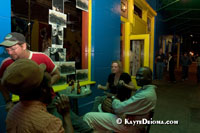 Unlike Bourbon Street, where you’ll find good music, but a great number of people are set on getting blitzed and there’s a certain sleaze factor, Frenchmen Street, located just outside the French Quarter in Faubourg Marigny, is all about the music. Although popular with locals, it has become a nightly haven for volunteers and relief workers to relax and unwind to good music after a hard day of gutting houses and trying to solve big problems. The half a dozen jazz clubs in a two block area, have a laid back bohemian feel.
Unlike Bourbon Street, where you’ll find good music, but a great number of people are set on getting blitzed and there’s a certain sleaze factor, Frenchmen Street, located just outside the French Quarter in Faubourg Marigny, is all about the music. Although popular with locals, it has become a nightly haven for volunteers and relief workers to relax and unwind to good music after a hard day of gutting houses and trying to solve big problems. The half a dozen jazz clubs in a two block area, have a laid back bohemian feel.
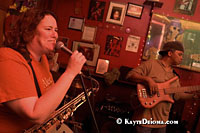 At small storefront establishments you can hear the music as well from the street out front as inside. With no cover charge, it’s easy to grab a seat or a corner of the bar to enjoy a solo drink and blend into the musical groove. At theApple Barrel I found Rebecca Barry and the FEMA No Checks, with Greg Madison on guitar and Sugar Bear on bass accompanying Rebecca’s vocals and sax. I recognized Sugar Bear from the Market Café that same morning where he had been playing with two other musicians. A couple doors down I found Sugar Bear’s morning compatriots, Pierre Pichon and Rafael Bas, playing with Java Swing at the Spotted Cat.
At small storefront establishments you can hear the music as well from the street out front as inside. With no cover charge, it’s easy to grab a seat or a corner of the bar to enjoy a solo drink and blend into the musical groove. At theApple Barrel I found Rebecca Barry and the FEMA No Checks, with Greg Madison on guitar and Sugar Bear on bass accompanying Rebecca’s vocals and sax. I recognized Sugar Bear from the Market Café that same morning where he had been playing with two other musicians. A couple doors down I found Sugar Bear’s morning compatriots, Pierre Pichon and Rafael Bas, playing with Java Swing at the Spotted Cat.
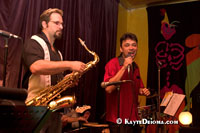 At Café Brasil on this Wednesday night, Fredy Omar con Su Banda were playing Latin jazz for fans spinning around the lightly crowded dance floor. I had met Omar a couple days before working at the Habitat for Humanity Musician’s Village building site. Omar was the first musician approved for a house at the site and he was putting in his sweat equity hours. Hanging out listening to the music, I recognized Habitat site supervisor Eli Grove. Some of the volunteers from Common Ground Relief were out on the dance floor. While New Orleans has always had a small town feel, the sparseness of the current population makes it that much more common to run into familiar faces when you’ve been in town a week.
At Café Brasil on this Wednesday night, Fredy Omar con Su Banda were playing Latin jazz for fans spinning around the lightly crowded dance floor. I had met Omar a couple days before working at the Habitat for Humanity Musician’s Village building site. Omar was the first musician approved for a house at the site and he was putting in his sweat equity hours. Hanging out listening to the music, I recognized Habitat site supervisor Eli Grove. Some of the volunteers from Common Ground Relief were out on the dance floor. While New Orleans has always had a small town feel, the sparseness of the current population makes it that much more common to run into familiar faces when you’ve been in town a week.
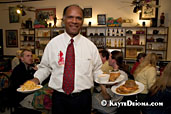 “Café Brasil is the incubator,” says Harold Toussant, a New Orleans native who waits tables at the Praline Connection, a New Orleans soul food restaurant across the street. “We know that every musician has a gift. Even if it is a little rough, people will be patient for them to develop the gift.” According to Toussant, those that have already polished their gift graduate to playing Snug Harbor, a block down and across the street. Snug Harboris known as the city’s premiere jazz club for up and coming artists as well as established names.
“Café Brasil is the incubator,” says Harold Toussant, a New Orleans native who waits tables at the Praline Connection, a New Orleans soul food restaurant across the street. “We know that every musician has a gift. Even if it is a little rough, people will be patient for them to develop the gift.” According to Toussant, those that have already polished their gift graduate to playing Snug Harbor, a block down and across the street. Snug Harboris known as the city’s premiere jazz club for up and coming artists as well as established names.
Frenchmen Street is located in Faubourg Marigny across Esplanade Avenue from the French Quarter. It meets Esplanade just below Decatur Street.

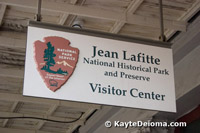 The Jean Lafitte National Historic Park and Preserveconsists of parks, preserves, bayous, swamps, historic sites and cultural centers all across southern Louisiana. In New Orleans, the National Historic Park has a French Quarter Visitor Center tucked in a courtyard off Decatur Street. If you want an in depth look at New Orleans and Louisiana history, go to the Cabildo on Jackson Square, but for an easily digestible overview of the city and its music, the Jean Lafitte NHP French Quarter Visitor Center is the place to go.
The Jean Lafitte National Historic Park and Preserveconsists of parks, preserves, bayous, swamps, historic sites and cultural centers all across southern Louisiana. In New Orleans, the National Historic Park has a French Quarter Visitor Center tucked in a courtyard off Decatur Street. If you want an in depth look at New Orleans and Louisiana history, go to the Cabildo on Jackson Square, but for an easily digestible overview of the city and its music, the Jean Lafitte NHP French Quarter Visitor Center is the place to go.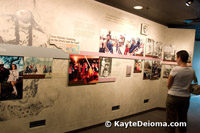 Traditional exhibits include background on the Native Americans of Louisiana, slave life, and the contribution of privateer and slave trader Jean Lafitte at the Battle of New Orleans, as well as the legend of Voodoo priestess Marie Laveau. Wall panels and audio recordings elucidate the development of the unique dialect of New Orleans, influenced by African slaves, and French, Irish, Italian and German immigrants, with some Native American place names thrown in for good measure.
Traditional exhibits include background on the Native Americans of Louisiana, slave life, and the contribution of privateer and slave trader Jean Lafitte at the Battle of New Orleans, as well as the legend of Voodoo priestess Marie Laveau. Wall panels and audio recordings elucidate the development of the unique dialect of New Orleans, influenced by African slaves, and French, Irish, Italian and German immigrants, with some Native American place names thrown in for good measure.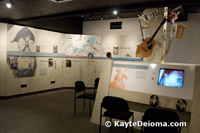 Pull up a chair and stay for a while at a multimedia presentation on the history of jazz. Put on a hea
Pull up a chair and stay for a while at a multimedia presentation on the history of jazz. Put on a hea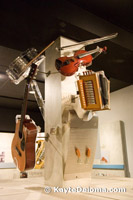 dset and watch and listen to some historic performances. A selection of instruments used in jazz, Cajun and Zydeco music are suspended from a column above the video console. There’s a brass trumpet, and saxophone, a guitar, a fiddle, and an accordion. The most unique instrument on display is the “frottoir” or rubboard, a molded, over-the-shoulder Louisiana invention which replaced the standard wood-frame washboard in Cajun and Zydeco music in 1946.
dset and watch and listen to some historic performances. A selection of instruments used in jazz, Cajun and Zydeco music are suspended from a column above the video console. There’s a brass trumpet, and saxophone, a guitar, a fiddle, and an accordion. The most unique instrument on display is the “frottoir” or rubboard, a molded, over-the-shoulder Louisiana invention which replaced the standard wood-frame washboard in Cajun and Zydeco music in 1946.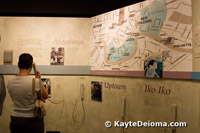 There are a couple other reasons why you might want to visit the Jean Lafitte National Historic Park French Quarter Visitor Center. It’s a good place to find public restrooms if you’re wandering the French Quarter. They also offer free 90-minute French Quarter tours daily at 9:30 am. Tickets are distributed to the first 25 people who show up for tickets after the Center opens at 9. There is a schedule of additional presentations and programs on the website.
There are a couple other reasons why you might want to visit the Jean Lafitte National Historic Park French Quarter Visitor Center. It’s a good place to find public restrooms if you’re wandering the French Quarter. They also offer free 90-minute French Quarter tours daily at 9:30 am. Tickets are distributed to the first 25 people who show up for tickets after the Center opens at 9. There is a schedule of additional presentations and programs on the website.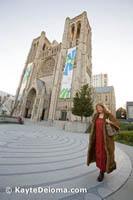 For a quick “time out” from the hustle and bustle of the city, head up Nob Hill to Grace Cathedral for a peaceful half hour of self-exploration on either of the two labyrinths on site. Labyrinths have been used as a tool for walking meditation in many cultures and religions for thousands of years. The deliberate path of spirals confined within a circle represents the journey of life. Grace Cathedral, the Bishop’s seat of the Episcopal Church of California,
For a quick “time out” from the hustle and bustle of the city, head up Nob Hill to Grace Cathedral for a peaceful half hour of self-exploration on either of the two labyrinths on site. Labyrinths have been used as a tool for walking meditation in many cultures and religions for thousands of years. The deliberate path of spirals confined within a circle represents the journey of life. Grace Cathedral, the Bishop’s seat of the Episcopal Church of California,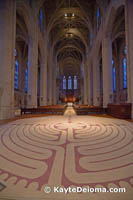 began construction in 1906 after the earthquake and fire and was finally completed in 1966. The Cathedral’s two labyrinths, added in the mid-1990s, replicate the design built into the floor of the Chartres Cathedral in France around the year 1220.
began construction in 1906 after the earthquake and fire and was finally completed in 1966. The Cathedral’s two labyrinths, added in the mid-1990s, replicate the design built into the floor of the Chartres Cathedral in France around the year 1220.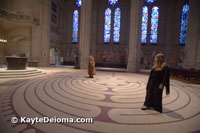 There are generally considered to be three phases to the walking meditation. The way from the outside of the circle to its center is the Purgation or releasing, where you let go of the distracting details of your life to quiet your mind and open yourself.
There are generally considered to be three phases to the walking meditation. The way from the outside of the circle to its center is the Purgation or releasing, where you let go of the distracting details of your life to quiet your mind and open yourself.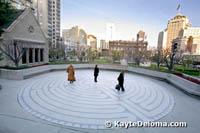 The indoor labyrinth is available only when the Cathedral is open to the public and is not having regular services, a wedding or other special events. There is also an outdoor terrazzo stone labyrinth at the front right corner of the church that is always open.
The indoor labyrinth is available only when the Cathedral is open to the public and is not having regular services, a wedding or other special events. There is also an outdoor terrazzo stone labyrinth at the front right corner of the church that is always open.